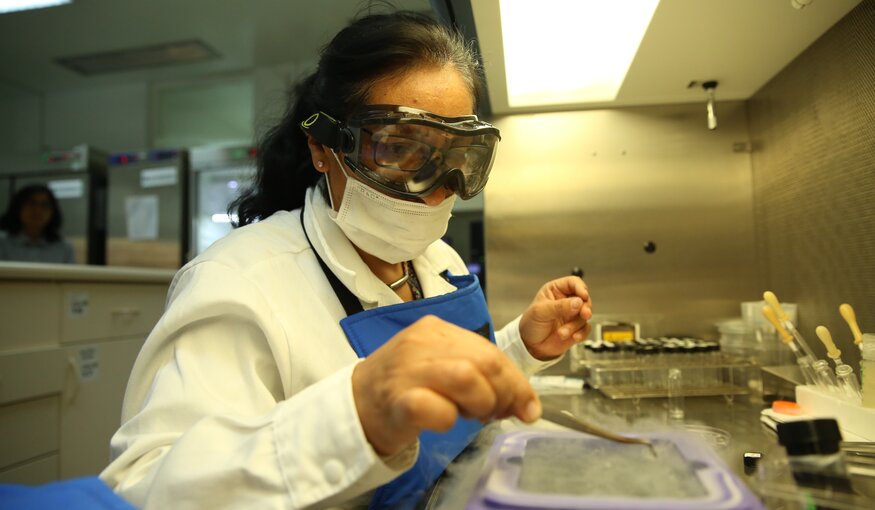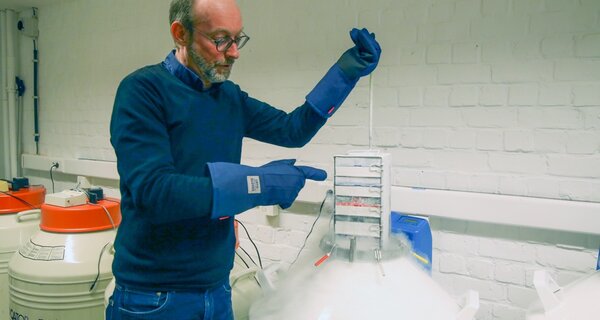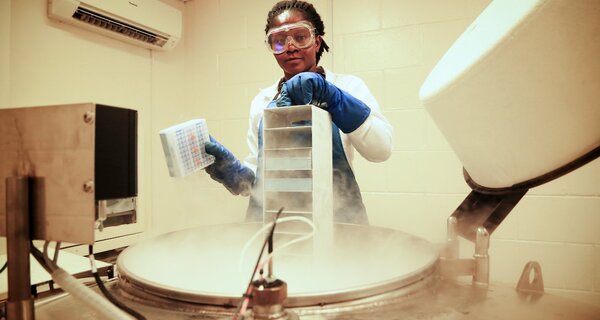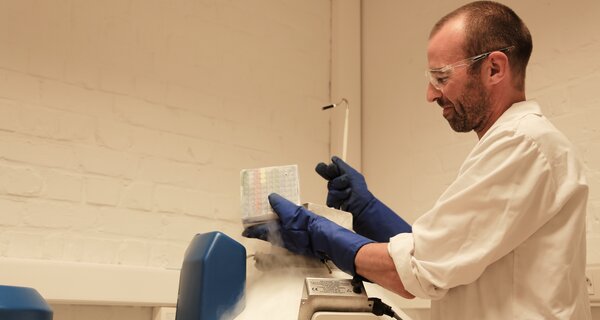An Initiative to Save Cryopreserved Crop Collections, Forever

Cryopreservation requires expertise and funding stability, but yields long term dividends for the preservation of crop diversity. Taken as a part of the Crop Trust's 2017 visit to CIP. (Photo Luis Salazar/Crop Trust)
28 September 2023
Many of the foods we cherish the most – bananas and potatoes, for example – don’t reproduce through seeds. They are propagated through vegetative means like tubers, suckers, and cuttings.
For this reason, the diversity of these crops can’t be kept in a genebank like the Svalbard Global Seed Vault, but rather in field genebanks or in vitro collections. That is, as living plants either growing in a field or glasshouse or inside test tubes. These are good conservation strategies, but they come with downsides and risks. Field collections are subject to climatic disturbances and natural disasters like flooding and drought. Plants kept in vitro need to be moved to new test tubes when they get too big, which is costly, time consuming, and can put a strain on the finances of less well-funded genebanks.
Luckily, another option exists: cryopreservation. It is a safe, long-term solution to conserving the diversity of these crops. By cooling plant material to incredibly cold temperatures (-196 C), cryo technicians can suspend the biological processes of the plant, thereby preserving it for future thawing and recovery -- potentially far future. Cryopreservation does, however, require special infrastructure and expertise, things sadly lacking in some parts of the world.
The Global Plant Cryopreservation Initiative (GPCI) promises to help change this. By initially establishing three regional cryopreservation hubs, expanding capacity at key genebanks, and developing a truly global cryopreservation network, the initiative seeks to expand the number and quality of collections in cryo facilities. This would greatly strengthen global preservation efforts and provide a critical back-up for collections conserving the genetic diversity of vegetatively propagated crops.
As David Ellis, former head of the genebank at the International Potato Center (CIP), and a recipient of the Crop Trust Legacy Award, explained in the most recent GROW webinar, a global cryo network is urgently needed as over 100,000 accessions of some humanity’s most important crops are at risk in in vitro and field collections worldwide. After the webinar, we connected with him to delve deeper into the Global Plant Cryopreservation Initiative.
Crop Trust: What do you see as the major impediments to cryopreservation?
David Ellis: The biggest limitation, in my view, is the piecemeal approach by which much plant cryopreservation research has been done due to the nature of short-term, project-based research funding. The Global Plant Cryopreservation Initiative will, for the first time, provide a longer-term vision for securely protecting these collections for centuries.
The awareness is there but, in our landscape, where the vast majority of funds are given for projects that take three years or less, researchers are pressured to show immediate results. This is very problematic. A single cryopreservation experiment could take a year and the optimization of a cryopreservation protocol to make it operational could take five or more years. And you have to repeat this process for every single crop that you wish to conserve. What works in potato is not directly applicable to sweetpotato, banana or yam.
This is why the initiative is so important. It will provide the funding stability to bridge the gap between experimental and operational cryopreservation.
Why does each plant need special attention when developing a protocol for its cryopreservation?
Let’s look at what we can conserve. There are a variety of plant tissues which are routinely cryopreserved: you can use shoot tips, dormant buds from temperate trees, seeds and embryos, and even pollen.
Then, there are three main methods for cryopreserving them: vitrification, dehydration and controlled freezing. Within each of these, there are myriad variations that can be applied, used or tested.
The importance of the cryo “hubs” concept for the Global Plant Cryopreservation Initiative is that these hubs will not only maintain the infrastructure but also the expertise to experimentally test the variables to develop the robust operational cryopreservation methods needed to securely cryopreserve the genetic resources collections from the target crops, whether it be yam, potato, or coconut.
During your time as head of the genebank at CIP, you and your team were able to build a leading cryo program. How were you able to do that?
We were very fortunate to have Rainer Vollmer as the manager of the CIP cryobank. Through the CGIAR Genebank Platform (now, the CGIAR Genebank Initiative), Rainer and the cryo team at CIP were provided with the resources and long-term funding to fully analyze the existing cryobank and eliminate sub-par material. A major hurdle was to admit that something you labored over for several decades and was state-of-the-art just a decade ago, was no longer fit for purpose.
It sounds like cryopreservation is a quickly evolving field. How would the Cryopreservation Initiative help keep genebanks from falling behind?
The primary outcome of the initiative will be to secure the long-term conservation of vital, irreplaceable at-risk crop diversity collections before they are lost forever. However, to achieve this, we need to build know-how and capacity amongst the three designated cryo “hubs” and our partners.
The GCPI will do this in several steps.
First of all, we need to identify the most at-risk clonal and recalcitrant crop collections.
Second, we’ll have to test existing cryo protocols to ensure that they’re effective across the broad diversity that exists in these collections. In cases where an existing protocol falls short, the cryo hubs will be tasked with creating and sharing new, more robust strategies that securely conserve the material. And finally, we’ll work on keeping our knowledge up-to-date through capacity building. Because cryo requires significant infrastructure, expertise and a long-term funding commitment, the vision is to expose all partners to the basic methodology and potential and train those who can demonstrate a long-term national commitment for sustained operations and maintenance of a cryobank.
Where will the efforts of the GCPI be targeted?
The first collections that will be targeted in the initiative are those in areas of the world which are rich in diversity but where the infrastructure and ability to protect these critical diversity does not exist. The Global Plant Cryopreservation Initiative will work with the countries where collections of critically important diversity of crops such as potato, cassava, sweetpotato, banana, yam, coffee, coconut, taro, ulluco and cacao currently exist but are not secure. We are seeking to securely cryopreserve a minimum of 2,500 accessions of the target crop collections during the first 5 years. The Initiative will operate much like the Svalbard Global Seed Vault, under the policy umbrella of the Plant Treaty.
The Global Plant Cryopreservation Initiative aims to address the funding gaps and the evolving nature of cryopreservation techniques to safeguard vital crop diversity collections for future generations. By bringing together expertise and funding, the initiative promises to provide the stability needed to expand the number of collections while also optimizing the techniques used to create them.
Categories: Potato, Climate Change



